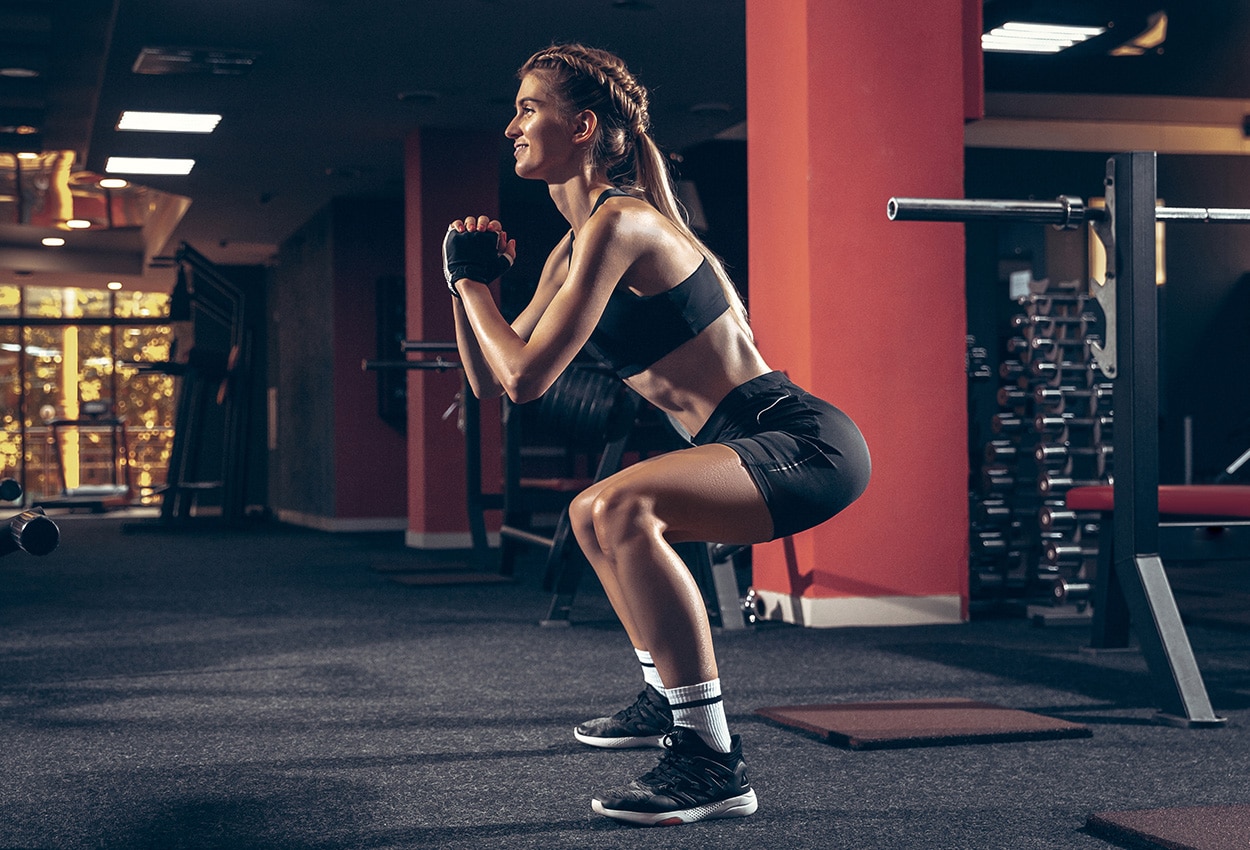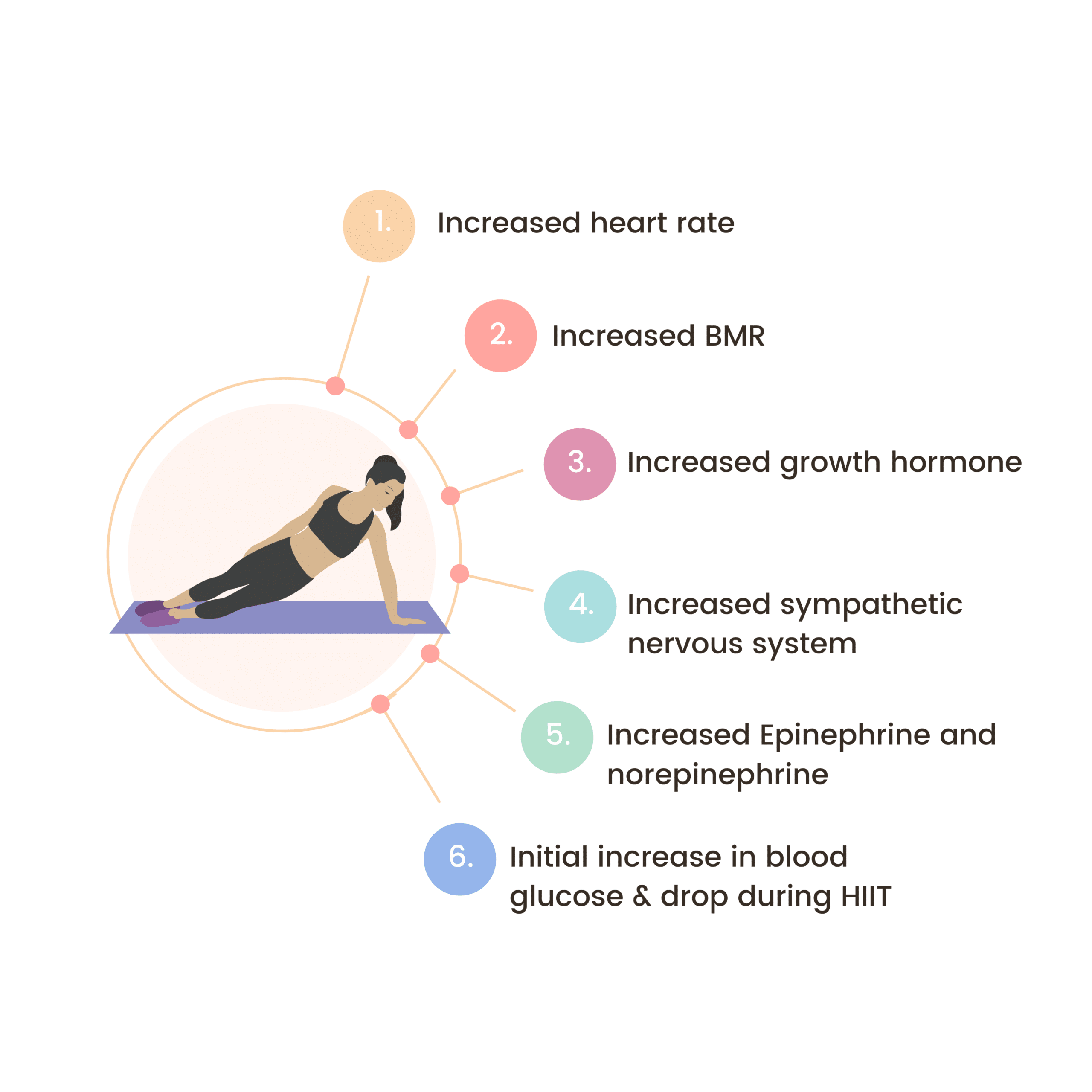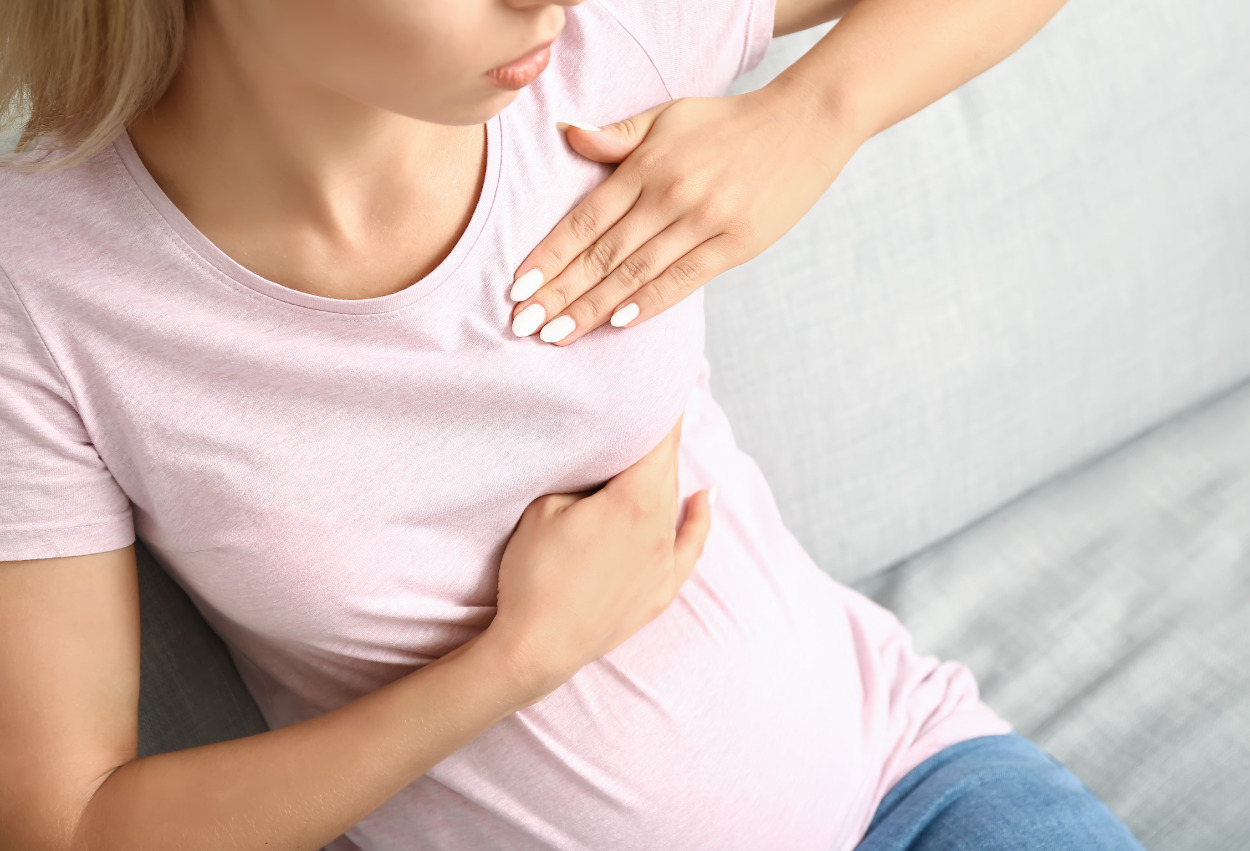Dr Ankita S
MBBS, MS, DNB OBGY
What is HIIT ?
High Intensity Interval Training – This is the workout routine with repeated bouts of high-intensity exercise and varied recovery (interval) times. In other words, you give all your effort to one particular exercise for a short period of time, followed by a period of rest.
For example, 30 seconds of sprints followed by 30 seconds of rest; 45 seconds of fast jumping jacks followed by 30 seconds of rest. Usually, the total workout lasts from 4 to 20 minutes, and the intervals last from 10 seconds to 1 minute.
The exercises might be anything from body weight exercises to power lifting to plyometrics to sprints to playground games.
Let’s see how the HIIT works
HIIT exercise activates your cells, thereby activating them to do their functions or increasing the capacity of the muscles to respond to the signals that have been received by the hormones.
The following depicts the immediate result of HIIT :
Benefits of HIIT
HIIT is presented as a time-effective training method that offers a number of health, fitness, and performance advantages.
- Improved insulin resistance
- Increased High Density Lipoprotein
- Manage your blood pressure
- Improved lung capacity
- Weight management
- Burning calories in short time
- Improved body Body Metabolic Rate
HIIT on PCOS
There are several concerns with PCOS. Despite following a strenuous diet and medications, the major symptoms and potential risks seem to be present in the eye sight. The HIIT practice focuses on the major concerns of PCOS, which are insulin resistance, weight management, and hormonal imbalance, especially with androgens.
HIIT on insulin resistance
Insulin sensitivity refers to a cell’s ability to absorb or receive glucose, which is not properly occurring in the case of PCOS. The cells continue to resist glucose absorption.
Practising exercise usually increases insulin resistance, among other benefits. HIIT practice results in a promising increase in insulin sensitivity of 23% to 58%. Regardless of the presence or absence of insulin, the contractions of the working muscle can activate the glucose shuttle transporters to take up glucose in the muscle.
HIIT on weight management
HIIT may specifically help reduce belly fat reserves.
However, analysing individual benefits for clients from HIIT is more speculative and more representative of the overall weight management because body composition change is so reflective of the mix of nutritional intake, behaviour modification, and activity.
HIIT on hormonal imbalance
The most commonly altered hormones in PCOS are free testosterone (fT), total testosterone (TT), sex hormone binding globulin (SHBG), the free androgen index (FAI), dehydroepiandrosterone (DHEA), DHEA sulphate (DHEA-S), and androstenedione (A4).
The research results show that after 12 weeks of following HIIT, the hormones fT, TT, and SHBG, in addition to DHEA-S, showed improved index scores.
(The research followed the HIIT with intense cycling, jogging, and walking)
HIIT on menstruation
Your delicate hormones are activated by intervals of hard exercise, and consistent exercise combined with the proper nutrition and medication helps to regulate the menstrual cycle.
The research shows that in women with PCOS, a 12-week HIIT programme combined with medication resulted in improvements in menstrual regulation.
Who should try HIIT
HIIT is a great exercise choice for individuals of all ages who are in good physical condition. In general, everyone can perform HIIT as long as they are healthy and don’t have any injuries or medical conditions that prevent them from exercising.
Based on research evidence, HIIT proves to be a beneficial strategy for women with PCOS since it helps improve major concerns of the condition such as insulin resistance, weight management, hormonal imbalance, and menstrual irregularities.
People with high blood pressure should start slowly and in intervals; eventually, it may normalise, and people with bone injuries or undergoing surgery should seek medical advice before proceeding.
A piece of counsel
Before beginning your HIIT journey, it is crucial to consult your physician and undergo an evaluation. HIIT can unmask underlying heart disorders, so it’s essential to start slowly and discontinue immediately if you face any difficulties. In individuals with a compromised cardiovascular system, HIIT can potentially lead to cardiac arrest.
Conclusion
HIIT offers greater improvements in aerobic capacity, insulin sensitivity and menstrual cyclicity, and larger reductions in hyperandrogenism. But relying only on HIIT might lead you to nowhere. The equal concentration on diet, medications (if needed), exercise and stress management are essential to holistically manage PCOS and prevent further complications.
References
1.Almenning, I., Rieber-Mohn, A., Lundgren, K. M., Shetelig Løvvik, T.,Garnæs, K. K., & Moholdt, T (2015). Effects of High IntensityInterval Training and Strength Training on Metabolic, Cardiovascular and Hormonal Outcomes in Women with Polycystic Ovary Syndrome: A Pilot Study. PloS one, 10(9),e0138793. https://doi.org/10.1371/journal.pone.0138793
2. Patten, R. K., McIlvenna, L. C., Levinger, I., Garnham, A. P.,Shorakae, S., Parker, A. G., McAinch, A. J.,Rodgers, R. J., Hiam, D., Moreno-Asso, A., & Stepto, N. K. (2022). High-intensity training elicits greater improvements in cardio-metabolic and reproductive outcomes than moderate-intensity training in women with polycystic ovary syndrome: a randomized clinical trial. Human reproduction (Oxford, England), 37(5), 1018-1029.https://doi.org/10.1093/humrep/deac047
3. Samadi, Z., Bambaeichi, E., Valiani, M., & Shahshahan, Z. (2019). Evaluation of Changes in Levels of Hyperandrogenism, Hirsutism and Menstrual Regulation After a Period of Aquatic High Intensity Interval Training in Women with Polycystic Ovary Syndrome. International journal of preventive medicine, 10, 187. https://doi.org/10.4103/ijpvm.IJPVM_360_18
4. Kravitz, L. (2014). Metabolic effects of HIIT. IDEA Fitness Journal, Vol. 11, No. 5, 16-18. https://www.unm.edu/~lkrvitz/Article%20folder/metabolicEffectsHII T.html
5. Shele, G., Genkil, J., & Speelman, D. (2020). A Systematic Review of the Effects of Exercise on Hormones in Women with Polycystic Ovary Syndrome. Journal of Functional Morphology and Kinesiology,5(2), 35. https://doi.org/10.3390/jfmk5020035
Frequently Asked Questions
Yes, HIIT has been shown to improve insulin sensitivity in women with PCOS, which can help manage insulin resistance.
HIIT may be beneficial for weight management, including reducing belly fat reserves, when combined with proper nutrition and lifestyle changes.
Research suggests that a 12-week HIIT program, combined with medication if needed, can improve menstrual regulation in women with PCOS.
HIIT is generally suitable for individuals in good physical condition and can be considered for women with PCOS to address specific concerns related to the condition.
While HIIT offers various benefits for PCOS, a comprehensive approach that includes a balanced diet, medications (if prescribed), exercise, and stress management is essential for holistic PCOS management and preventing further complications.
Note: Before starting any exercise program, especially HIIT, individuals with medical conditions or injuries should consult their healthcare provider.
Dr Ankita S
MBBS, MS, DNB OBGY
Priya
M.Sc Nutrition and Dietetics
Priya
M.Sc Nutrition and Dietetics
Related Blogs
- How to prevent Prediabetes from Turning into DiabetesSeptember 19, 2023
- Unravelling the connection: insulin Resistance and PCOSSeptember 8, 2023









